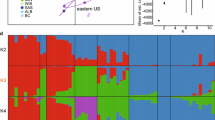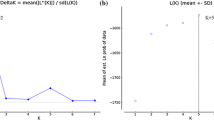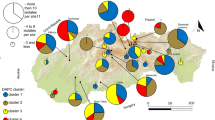Abstract
Introduced plant pathogens are increasingly recognized as a major threat to biodiversity and ecosystem functioning. One such pathogen, the causal agent of the devastating ash dieback in Europe, Hymenoscyphus fraxineus, was most likely introduced into Europe from eastern Asia in the 1990s. To investigate the genetic population structure of this invasive fungus at the epidemic disease front (Switzerland) and in the post-epidemic phase (Lithuania), a total of 847 H. fraxineus isolates were genotyped at 11 microsatellite loci. Among these isolates, 244 multilocus genotypes were found in five post-epidemic subpopulations (367 isolates) of the fungus and 263 in five epidemic subpopulations (480 isolates). No genetic differentiation was found between isolates recovered from bark lesions and fallen leaf petioles, which suggests that all H. fraxineus genotypes have the potential to induce bark infections on living trees and to survive saprophytically. Moreover, no genetic differentiation and no difference in genetic diversity were detected between the epidemic and post-epidemic populations. The entire genetic diversity present in the original founding populations in north-eastern Europe seems to have been transmitted to the epidemic disease front. Nonetheless, gene flow among post-epidemic subpopulations occurs slightly more random than among epidemic subpopulations. Furthermore, the probability of correct assignment of a particular H. fraxineus genotype to its subpopulation of origin was greater in Switzerland than in Lithuania. These two analyses point to weak founder effects at the disease front.





Similar content being viewed by others
References
Agapow P-M, Burt A (2001) Indices of multilocus linkage disequilibrium. Mol Ecol Notes 1:101–102
Allendorf FW, Lundquist LL (2003) Introduction: population biology, evolution, and control of invasive species. Conserv Biol 17(1):24–30
Anderson PK, Cunningham AA, Patel NG, Morales FJ, Epstein PR, Daszak P (2004) Emerging infectious diseases of plants: pathogen pollution, climate change and agrotechnology drivers. Trends Ecol Evol 19(10):535–544
Arnaud-Haond S, Belkhir K (2007) GENCLONE: a computer program to analyse genotypic data, test for clonality and describe spatial clonal organization. Mol Ecol Notes 7:15–17
Austerlitz F, Jung-Muller B, Godelle B, Gouyon P-H (1997) Evolution of coalescence times, genetic diversity and structure during colonization. Theor Popul Biol 51:148–164
Barrett LG, Thrall PH, Burdon JJ, Linde CC (2008) Life history determines genetic structure and evolutionary potential of host-parasite interactions. Trends Ecol Evol 23(12):678–685
Bengtsson SBK, Vasaitis R, Kirisits T, Solheim H, Stenlid J (2012) Population structure of Hymenoscyphus pseudoalbidus and its genetic relationship to Hymenoscyphus albidus. Fungal Ecol 5(2):147–153
Billiard S, Lopez-Villavicencio M, Hood ME, Giraud T (2013) Sex, outcrossing and mating types? Unsolved questions in fungi and beyond. J Evol Biol 25:1020–1038
Boyd IL, Freer-Smith PH, Gilligan CA, Godfray HCJ (2013) The consequence of tree pests and diseases for ecosystem services. Science 342(6160):1235773
Brasier CM (2008) The biosecurity threat to the UK and global environment from international trade in plants. Plant Pathol 57:792–808
Brasier C, Webber J (2013) Vegetative incompatibility in the ash dieback pathogen Hymenoscyphus pseudoalbidus and its ecological implications. Fungal Ecol 6(6):501–512
Burdon JJ, Silk J (1997) Sources and patterns of diversity in plant pathogenic fungi. Phytopathology 87:664–669
Croucher PP, Mascheretti S, Garbelotto M (2013) Combining field epidemiological information and genetic data to comprehensively reconstruct the invasion history and the microevolution of the sudden oak death agent Phytophthora ramorum (Stramenopila: Oomycetes) in California. Biol Invasions 15:2281–2297
Dean MD, Ballard JWO (2004) Linking phylogenetics with population genetics to reconstruct the geographic origin of a species. Mol Phylogenet Evol 32:998–1009
DEFRA (2013) Chalara Management Plan. Department for Environment Food and Rural Affairs, London. https://www.gov.uk/government/uploads/system/uploads/attachment_data/file/221051/pb13936-chalara-management-plan-201303.pdf. Accessed 10 June 2014
Desprez-Loustau M-L, Courtecuisse R, Robin C et al (2009) Species diversity and drivers of spread of alien fungi (sensu lato) in Europe with a particular focus on France. Biol Invasions 12:157–172
Dixon P (2003) VEGAN, a package of R functions for community ecology. J Veg Sci 14:927–930
Dutech C, Fabreguettes O, Capdevielle X, Robin C (2010) Multiple introductions of divergent genetic lineages in an invasive fungal pathogen, Cryphonectria parasitica in France. Heredity 105(2):220–228
Dutech C, Barrès B, Bridier J, Robin C, Milgroom MG, Ravigné V (2012) The chestnut blight fungus world tour: successive introduction events from diverse origins in an invasive plant fungal pathogen. Mol Ecol 21(16):3931–3946
Engesser R, Queloz V, Meier F, Kowalski T, Holdenrieder O (2009) Das Triebsterben der Esche in der Schweiz. [Ash dieback in Switzerland]. Wald und Holz 6:24–27 (in German)
Evanno G, Regnaut S, Goudet J (2005) Detecting the number of clusters of individuals using the software STRUCTURE: a simulation study. Mol Ecol 14:2611–2620
Excoffier L, Ray N (2008) Surfing during population expansions promotes genetic revolutions and structuration. Trends Ecol Evol 23(7):347–351
Falush D, Stephens M, Pritchard JK (2003) Inference of population structure using multilocus genotype data: linked loci and correlated allele frequencies. Genetics 164:1567–1587
Fichtner EJ, Rizzo DM, Kirk SA, Webber JF (2012) Infectivity and sporulation potential of Phytophthora kernoviae to select North American native plants. Plant Pathol 61(2):224–233
Fontaine M, Austerlitz F, Giraud T et al (2013) Genetic signature of a range expansion and leap-frog event after the recent invasion of Europe by the grapevine downy mildew pathogen Plasmopara viticola. Mol Ecol 22:2771–2786
Ghabrial SA, Suzuki N (2009) Viruses of plant pathogenic fungi. Annu Rev Phytopathol 47:353–384
Goudet J (2001) FSTAT, A Program to Estimate and Test Gene Diversities and Fixation Indices. Version 2.9.3, Department of Ecology and Evolution, University of Lausanne, Switzerland. http://www2.unil.ch/popgen/softwares/
Gross A, Grünig CR, Queloz V, Holdenrieder O (2012) A molecular toolkit for population genetic investigations of the ash dieback pathogen Hymenoscyphus pseudoalbidus. Forest Pathol 42:252–264
Gross A, Holdenrieder O, Pautasso M, Queloz V, Sieber TN (2014a) Hymenoscyphus pseudoalbidus, the causal agent of European ash dieback. Mol Plant Pathol 15(1):5–21
Gross A, Hosoya T, Queloz V (2014b) Population structure of the invasive forest pathogen Hymenoscyphus pseudoalbidus. Mol Ecol 23:2943–2960
Grünwald NJ, Garbelotto M, Goss EM, Heungens K, Prospero S (2012) Emergence of the sudden oak death pathogen Phytophthora ramorum. Trends Microbiol 20(3):131–138
Husson C, Scala B, Caёl O, Frey P, Feau N, Ioos R, Marçais B (2011) Chalara fraxinea is an invasive pathogen in France. Eur J Plant Pathol 130:311–324
Jombart T (2008) adegenet: a R package for the multivariate analysis of genetic markers. Bioinformatics 24(11):1403–1405
Jombart T, Devillard S, Balloux F (2010) Discriminant analysis of principal components: a new method for the analysis of genetically structured populations. BMC Genet 11(1):94
Kamvar ZN, Tabima JF, Grünwald NJ (2014) Poppr: an R package for genetic analysis of populations with clonal, partially clonal, and/or sexual reproduction. PeerJ 2:e281. http://dx.doi.org/10.7717/peerj.281. http://cran.r-project.org/web/packages/poppr/
Kirisits T, Dämpfle L, Kräutler K (2013) Hymenoscyphus albidus is not associated with an anamorphic stage and displays slower growth than Hymenoscyphus pseudoalbidus on agar media. Forest Pathol 43(5):386–389
Klopfstein S, Currat M, Excoffier L (2006) The fate of mutations surfing on the wave of a range expansion. Mol Biol Evol 23(3):482–490
Kowalski T (2006) Chalara fraxinea sp. nov. associated with dieback of ash (Fraxinus excelsior) in Poland. Forest Pathol 36(4):264–270
Kowalski T, Holdenrieder O (2009) Pathogenicity of Chalara fraxinea. Forest Pathol 39:1–7
Kraj W, Zarek M, Kowalski T (2012) Genetic variability of Chalara fraxinea, dieback cause of European ash (Fraxinus excelsior L.). Mycol Prog 11:37–45
Liu YC, Milgroom MG (2007) High diversity of vegetative compatibility types in Cryphonectria parasitica in Japan and China. Mycologia 99(2):279–284
Liu YC, Cortesi P, Double ML, MacDonald WL, Milgroom MG (1996) Diversity and multilocus genetic structure in populations of Cryphonectria parasitica. Phytopathology 86(12):1344–1351
Lygis V, Bakys R, Gustiene A, Burokiene D, Matelis A, Vasaitis R (2014) Forest self-regeneration following clear-felling of dieback-affected Fraxinus excelsior: focus on ash. Eur J Forest Res 133:501–510
McDonald BA (1997) The population genetics of fungi: tools and techniques. Phytopathology 87:448–453
McKinney LV, Nielsen LR, Collinge DB, Thomsen IM, Hansen JK, Kjær ED (2014) The ash dieback crisis: genetic variation in resistance can prove a long-term solution. Plant Pathol 63(3):485–499
Milgroom MG, Sotirovski K, Spica D et al (2008) Clonal population structure of the chestnut blight fungus in expanding ranges in Southeastern Europe. Mol Ecol 17(20):4446–4458
Pautasso M, Aas G, Queloz V, Holdenrieder O (2013) European ash (Fraxinus excelsior) dieback—a conservation biology challenge. Biol Conserv 158:37–49
Peakall R, Smouse PE (2006) GENALEX 6: genetic analysis in Excel. Population genetic software for teaching and research. Mol Ecol Notes 6:288–295
Pritchard JK, Stephens M, Donnelly P (2000) Inference of population structure using multilocus genotype data. Genetics 155:945–959
Prospero S, Rigling D (2012) Invasion genetics of the chestnut blight fungus Cryphonectria parasitica in Switzerland. Phytopathology 102:73–82
Prospero S, Rigling D (2013) Chestnut blight. In: Nicolotti G, Gonthier P (eds) Infectious forest diseases. CAB International, Wallingford, pp 318–339
R Development Core Team (2014) R: A language and environment for statistical computing. R Foundation for Statistical Computing, Vienna, Austria. http://www.R-project.org/. Accessed 6 November 2014
Roques L, Garnier J, Hamel F, Klein EK (2012) Allee effect promotes diversity in traveling waves of colonization. PNAS 109(23):8828–8833
Rousset F (1997) Genetic differentiation and estimation of gene flow from F-statistics under isolation by distance. Genetics 145:1219–1228
Rousset F (2008) Genepop’007: a complete reimplementation of the Genepop software for Windows and Linux. Mol Ecol Resources 8:103–106
Sakai AK, Allendorf FW, Holt JS et al (2001) The population biology of invasive species. Annu Rev Ecol Syst 32:305–332
Santini A, Ghelardini L, De Pace C et al (2013) Biogeographical patterns and determinants of invasion by forest pathogens in Europe. New Phytol 197:238–250
Schoebel CN, Stewart J, Gruenwald NJ, Rigling D, Prospero S (2014a) Population history and pathways of spread of the plant pathogen Phytophthora plurivora. PLoS ONE 9(1):e85368
Schoebel CN, Zoller S, Rigling D (2014b) Detection and genetic characterization of a novel mycovirus in Hymenoscyphus fraxineus, the causal agent of ash dieback. Infect Gen Evol 28:78–86
Szpiech ZA, Jakobsson M, Rosenberg NA (2008) ADZE: a rarefaction approach for counting alleles private to combinations of populations. Bioinformatics 24:2498–2504
Timmermann V, Børja I, Hietala AM, Kirisits T, Solheim H (2011) Ash dieback: pathogen spread and diurnal patterns of ascospore dispersal, with special emphasis on Norway. EPPO Bull 41:14–20
Weir BS, Cockerham CC (1984) Estimating F-statistics for the analysis of population-structure. Evolution 38:1358–1370
Westphal MI, Browne M, MacKinnon K, Noble I (2008) The link between international trade and the global distribution of invasive alien species. Biol Invasions 10:391–398
Xhaard C, Barrès B, Andrieux A, Bousset L, Halkett F, Frey P (2012) Disentangling the genetic origins of a plant pathogen during disease spread using an original molecular epidemiology approach. Mol Ecol 21:2383–2398
Acknowledgments
We would like to thank the foresters in both countries for their help in finding diseased ash stands, as well as Hélène Blauenstein, Romina Sigrist and Donata Kinčiūtė for their help with field and laboratory work. We are also grateful to the Genetic Diversity Center of ETH Zurich for their support, and to the European Cooperation in the Field of Scientific and Technical Research (COST) Programme Action No. FP1103 ‘FRAXBACK’ for granting two Short-Term Scientific Missions (STSM’s). This study was financially supported by the Lithuanian-Swiss cooperation programme to reduce economic and social disparities within the enlarged European Union (project grant agreement no. CH-3-ŠMM-01/12). Finally, we are grateful to Silvia Dingwall for English revision of the manuscript and to the two anonymous reviewers for valuable comments on the manuscript.
Conflict of interest
The authors declare that they have no conflict of interest.
Author information
Authors and Affiliations
Corresponding author
Electronic supplementary material
Below is the link to the electronic supplementary material.
Rights and permissions
About this article
Cite this article
Burokiene, D., Prospero, S., Jung, E. et al. Genetic population structure of the invasive ash dieback pathogen Hymenoscyphus fraxineus in its expanding range. Biol Invasions 17, 2743–2756 (2015). https://doi.org/10.1007/s10530-015-0911-6
Received:
Accepted:
Published:
Issue Date:
DOI: https://doi.org/10.1007/s10530-015-0911-6




